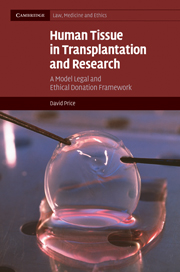Book contents
- Frontmatter
- Dedication
- Contents
- Preface
- Table of cases cited
- Table of selected statutory sources
- Introduction
- 1 Human biological materials
- 2 Interests in the living body and corpse
- 3 Eliciting wishes
- 4 Consent to donation
- 5 Presumed consent
- 6 Informed consent
- 7 Living donation
- 8 Property in human material
- Conclusion
- Index
- References
8 - Property in human material
Published online by Cambridge University Press: 05 July 2014
- Frontmatter
- Dedication
- Contents
- Preface
- Table of cases cited
- Table of selected statutory sources
- Introduction
- 1 Human biological materials
- 2 Interests in the living body and corpse
- 3 Eliciting wishes
- 4 Consent to donation
- 5 Presumed consent
- 6 Informed consent
- 7 Living donation
- 8 Property in human material
- Conclusion
- Index
- References
Summary
There is a widespread adverse reaction to the notion of property rights in the human body. These are both intrinsic and instrumental reservations, in that they stem from essentialist views regarding the nature of the person and the proper respect and dignity owed, and consequentialist concerns relating to the effects of objectification of the body. The latter are conceptual and pragmatic. In particular, potential commercial trading in body parts is commonly viewed as an inextricable aspect of recognising property in human biological materials, drawing criticisms of commodification and concerns that such rights located in the tissue source would impede or undermine vital activities in the public interest. But not only are such objections able to be countered, the very unique nature of property-based interests is a persuasive factor in favour of a framework of property rights in this context. Indeed, it may be that property rights in donors paradoxically serve to constrain commercial practices and the unauthorised use of such materials by third parties.
Whilst the law’s attitude to property rights in human body parts is at best ambiguous, it should not be supposed that property rights are anathema under existing schema. In fact, paradoxically, property rights have been juridically invoked specifically in order to protect the legitimate interests of possessors and users of biological materials, whether this be as part of the process of forensic investigation, anatomical or post-mortem examination, retention of tissue samples for research, etc. Not only are such rights fairly pervasive as regards third-party users of tissue, they are crucial in order to further such activities, although their ambit is currently piecemeal and unreliable; failing to provide sufficient confidence for storers and users. As Magnusson states ‘Unless some form of proprietary rights are recognised in cadaveric specimens, museums and medical school specimens could be damaged, stolen, or in fact retained with impunity’. Indeed, almost everyone would endorse property rights of some hue or other in this context.
- Type
- Chapter
- Information
- Human Tissue in Transplantation and ResearchA Model Legal and Ethical Donation Framework, pp. 230 - 281Publisher: Cambridge University PressPrint publication year: 2009

